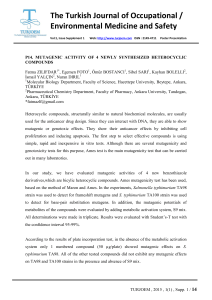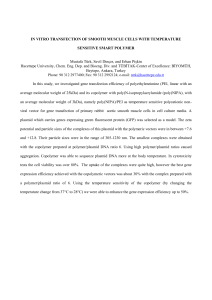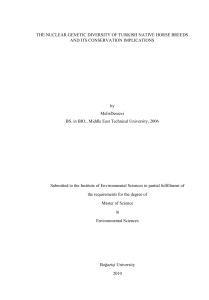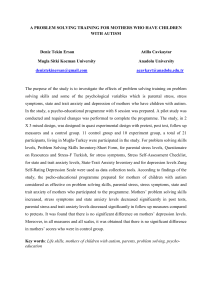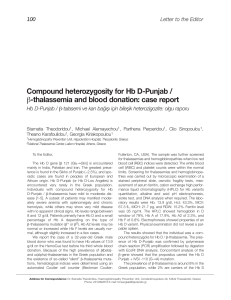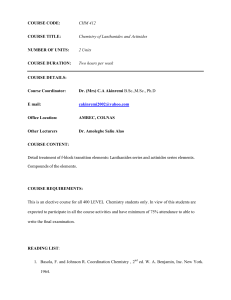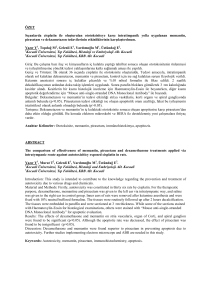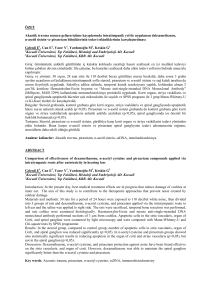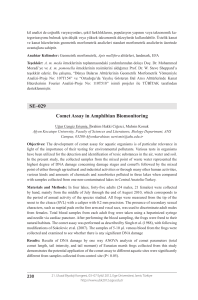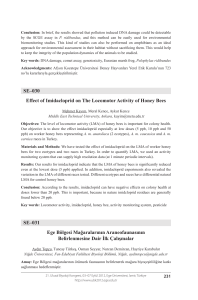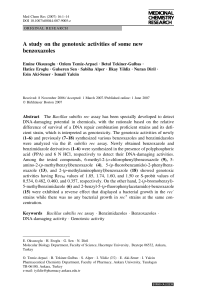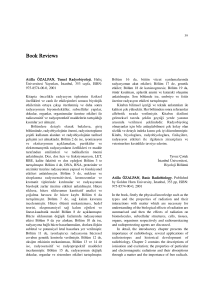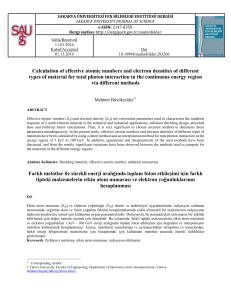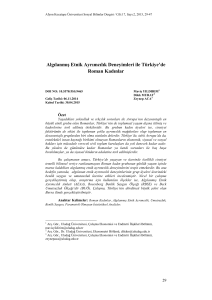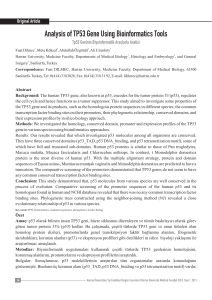ARAŞTIRMA MAKALESiIRESEARCH ARTICLE SYNTHESIS AND
advertisement
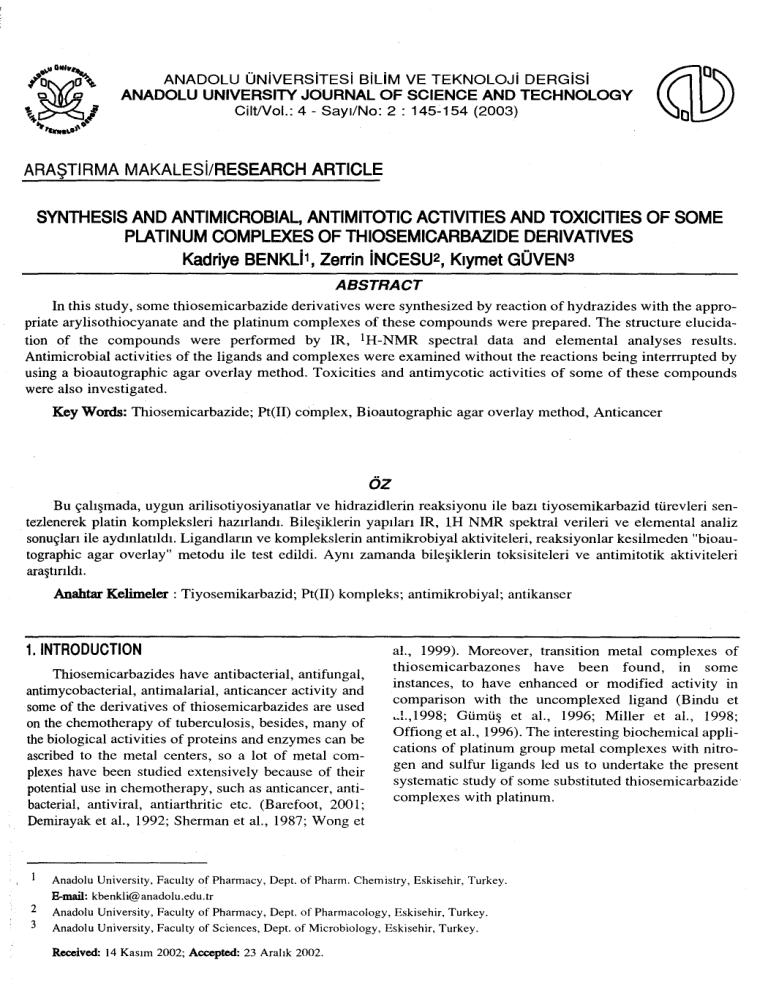
ANADOLU ÜNivERSiTESi BiliM VE TEKNOLOJi DERGiSi ANADOLU UNIVERSITY JOURNAL OF SCIENCE AND TECHNOLOGY Cilt/Vol.: 4 - Sayı/No: 2: 145-154 (2003) ARAŞTIRMA MAKALESiIRESEARCH ARTICLE SYNTHESIS AND ANTIMICROBIAL, ANTIMITOTIC ACTIVITIES AND TOXICITIES OF SOME PLATINUM COMPLEXES OF THIOSEMICARBAZIDE DERIVATIVES Kadriye BENKLi 1, Zerrin iNCESU2, Kıymet GÜVEN3 AB5TRACT In this study, some thiosemicarbazide derivatives were synthesized by reaction of hydrazides with the appropriate arylisothiocyanate and the platinum complexes of these compounds were prepared. The structure elucidation of the compounds were performed by IR, ı H-NMR spectral data and elemental analyses results. Antimicrobial activities of the ligands and complexes were examined without the reactions being interrrupted by using a bioautographic agar overlay method. Toxicities and antimycotic activities of some of these compounds were alsa investigated. Key Words: Thiosemicarbazide; Pt(II) complex, Bioautographic agar overlay method, Anticancer öz uygun arilisotiyosiyanatlar ve hidrazidlerin reaksiyonu ile bazı tiyosemikarbazid türevieri sentezlerıerek platin kompleksieri hazırlandı. Bileşiklerin yapıları IR, LH NMR spektral verileri ve elemental analiz sonuçları ile aydınlatıldı. Ligandıarın ve kompleksierin antimikrobiyal aktiviteleri, reaksiyonlar kesilmeden "bioautographic agar overlay" metodu ile test edildi. Aynı zamanda bileşiklerin toksisiteleri ve antimitotik aktiviteleri Bu çalışmada, araştırıldı. Anahtar Kelimeler: Tiyosemikarbazid; Pt(II) kompleks; antimikrobiyal; antikanser 1. INTRODUCTION Thiosemicarbazides have antibacterial, antifungal, antimycobacterial, arıtimalarial, anticancer activity and some of the derivatives of thiosemicarbazides are used on the chemotherapy of tuberculosis, besides, many of the biological activities of proteins and enzymes can be ascribed to the metal centers, so a lot of metal complexes have been studied extensively because of their potential use in chemotherapy, such as anticancer, antibacterial, antiviral, antiarthritic ete. (Barefoot, 2001; Demirayak et aL., 1992; Sherman et aL., 1987; Wong et aL., 1999). Moreover, transıtıon metal complexes of thiosemicarbazones have been found, in some instances, to have enhanced or modified activity in comparison with the uncomplexed ligand (Bindu et "1.,1998; Gümüş et aL., 1996; Miller et al., 1998; Offiong et aL., 1996). The interesting biochemical applications of platinum group metal complexes with nitrogen and sulfur ligands led us to undertake the present systematic study of some substituted thiosemicarbazide complexes with platinum. Anadolu University, Faculty ofPharmacy, Dept. ofPharm. Chemistry, Eskisehir, Turkey. E-ınail: 2 [email protected] Anadolu University, Faculty ofPharmacy, Dept. ofPharmacology, Eskisehir, Turkey. 3 Anadolu University, Faculty of Sciences, Dept. of Microbiology, Eskisehir, Turkey. Received: 14 Kasım 2002; Accepted: 23 Aralık 2002. 146 Anadol~ Üniversitesi Bilim ve Teknoloji Dergisi, 4 (2) In this study, NLaryloxyaceto-N4-aryl-3-thiosemicarbazide derivatives were synthesized by reaction of aryloxyacetohydrazides with the appropriate arylisothiocyanate and the platinum complexes of these compounds were prepared (Atalay et aL., 1998; Beraldo et al., 1998; McCaffrey et aL., 1997; Mylonas et al., 1988; Nagasawa et aL., 1998). The structure elucidation of the compounds were performed by using IR, 1H-NMR spectral data and elemental analyses results (Bergs et aL., 1997; El-Shadaw, 1991; Yalçın et aL., 1993). Antimicrobial activities of the ligands and complexes were examined without the reactions being interrrupted by using a bioautographic agar overlay method (Gibbons et aL., 1998; Rahalison et al., 1991) which can also be used to the search for antimicrobial activity of some of the stereochemically non-rigid metal complexes. In addition, toxic effects of these compounds were studied by MTT(3-(4,S-dimethylthiazolyl-2-)-2,Sdiphenyl tetrazolium bromide) assay, and also antimycotic effect was investigated by BrdU-proliferative assay in fibroblast like mouse embryo cells (Merante et al., 1996; Scioscia, 1997). 2. MATERIALS AND METHODS Melting points were determined by using a Gallenkamp apparatus and given uncorrected. Spectroscopic data were recorded on the following instruments : IR : Schimadzu 43S IR spectrophotometer; 1H NMR: DPX 400 NMR spectrometer, Microanalyses: Leco CHNS Elemental Analyscs Apparatus. 2.1. Synthesis of the ligand N1-aryloxyaceto-N4-aryl-3- thiosemicarbazide derivatives (I-IV) A mixture of suitable aryloxyacetohydrazide (S mmol) and arylisothiocyanate (S mmol) in ethanol (lOO ml) was refluxed for 2 h. The precipitate was filtered and crystallised from methanol-water mixture (yield-80%) (Table I). 2.2. Preparation of the Pt complexes Scherne ı. i: IR(KBr)nmax(cm- I): 3275-3050 (N-H), 1671 (C=O), 1240 (C=S), 838 (I,4-disübs), 741,681 (monosübs.). IH-NMR s(ppm): 2.23 (3H, s), 4.52 (2H, bs), 6.8-7.32 (9H, m), 9.5 (2H, s), 10.25, (lH, s). EL. An. Calc. (% C-H-N): 60.93-5.43-13.32; Found(%C-HN) : 60.71-5.20-13.40. II: IR(KBr)nmax(cm- I): 1647 (C=O), 1482 (C=N). 1160 (CO), 845 (I,4-disübs.). 771,722 (monosübs.), 330 (M-N), 292 (M- CL), IH-NMR s(ppm): 2.44 (3H, s), 3.52 (2H, bLS), 7.98-8.52 (9H, m). EL. An. Found(%C-H-N) : 36.71-2.30-8.41. ın: IR(Kbr)nmax(cm- I): 3375-3000 (N-H), 1664 (C=O), 1245 (C-S), 829 (I,4-disübs.). 744 (I,2-disübs.). IH-NMR s(ppm): 4.71 (2h, bs). 6.59-7.45 (8H, m), 9.71 (2H, s), 10.16, (lH, s). EL. An. Calc.(%C-H-N): 53.65-4.20- 12.51; Found(%C-H-N) : 53.31-4.4612.66. IV: IR(KBr)nma/cm- I): 1607 (C=O), 1483 (C=N), 813 (1,4- ' disübs.), 751 (i ,2-disübs,), 339 (M-N), 293 (M-S). 1H-NMR s(ppm): 5.01 (2H, s), 6.05-8.64(8H, m). EL. An. Found(%C-H-N) : 34.55-2.60-7.41. V: IR(KBr)nma/cm- 1) : 1664 (C=O), 1485 (C=N), 854 (1,4disübs.), 747 (i ,2-disübs.), 336 (M-N), 296 (M-S). i H-NMR s(ppm): 2.49 (3H, s), 3.24 (2H, bLS), 8.06-8.60 (8H, m). EL. An. Found(%C-H-N) : 23.71-1.87-5.41. VI: IR(KBr)nmax(cm- 1) : 1604 (C=O), 1483 (C=N), 750,687 (monosübs.), 745 (I,2-disübs.), 321 (M-N), 285 (M-S). IH-NMR s(ppm): 5,02 (2H, br.s), 6.70-7.90 (9H, m). EL. An. Found(%C-HN) : 23.71-1.87-5.41. VII: IR(KBr)nmax(cm- 1) : 3305-31 Lo (N-H), 1660(C-O), 1245 (C=S), 838 (I,4-disübs.), 740 (I,2-disübs.). 1H-NMR s(ppm): 2.30 (3H, s), 4.78 (2H, bs), 6.98-7.46 (8H, m), 9.63 (2H, s), 10.18, (IH. s). EL. Cn. Calc.(%C-H-N) : 54.93-4.61-12.01: Found(%C-H-N) : 54.91-4.45-11.78, VIII : 1R(KBr)nmax(cm- 1) : 3380-3160 (N-H), 1669 (C=O), 1293 (C=S), 800,695 (monosübs.), 748 (i ,2-disübs.), i H-NMR s(ppm): 4,73 (2H, bs), 6.9~-7.41 (9H, m), 9.62 (2H, s), 10.15, (lH, s), EL. An. Calc.(%C-H-N) : 54,93-4.61-12.01; Found(%C-H-N) : 54.91 -4.45-11.78. (la-ıVa) Table I. Some Characteristics of The Compounds. NI -ary loxyaceto- N'l-ary1-3 -thiosemicarbazide derivatives (O.S mmol) and K2P tC 14 (O.S mmol) in DMF (S mL) were stirred at 2SoC for 8h. The solution was filtered and then kept in the refrigerator for 24 h. The complexes were precipitated after the addition of sodium acetate as a buffering agent and filtered. After washing several times with ethanol and diethyl ether, the final products were dried in vacuo (yield -SO%) (Table I). Reactions were showed in the Scheme ı. Comp R R' i H CH) Mp, CC) Yield(%) 171 82 C I 6H 17N)Oı S Formula MoL Mass 315.384 II H CH) >300 44 CI6HI5N)OıSPt 508.458 III CI CH) 158 73 CI6HI6NJOıSCI 349.827 48 CI6HI4NJÜıSClPt 542.901 LV CI CH) >300 V CL Ci 169 85 CI5Hı)N)OıSClı 370.244 VI CI CL >300 50 C IsH14NJÜıSClıPt 563.318 VII CI H 140 76 CI5HI4N)OıSCI 335.797 VIII CL H >300 43 CI5HI4NJOıSC!Pt 528.871 Anadolu University Journal of Science and Technology, 4 (2) 2.3. Antimicrobial activity assay TLC bioautographic overlay assay of Gibbons and Gray was used to determine the antimicrobial activity of ligands and the platinum oomplexes of thiosemicarbazide derivatives. Staphylacoccus aureus ATCC 6538P, Escherichia coli ATCC 25922, Pseudomonas aureuginosa ATCC 27853, Enterabacter feacalis ATCC 29212 were obtained from Ege University, Faculty of Seienee and Candida albicans was kindly obtained from Osmangazi University Medical Faeulty. A base of nutrient agar was poured into a dish and allowed to solidify. The compounds were run on a TLC plate with petroleum ether:ethyl aeetate (l: 1 and 2:1) as a developing solvent. An inoculum of the eultures at a titer of 105cfu/ml in Müeller Hintan Broth (Merck) was prepared and nutrient agar was added at 7.5 g/lt to thicken the medium. TLC plate was placed on the nutrient agar base and then the medium containing test organism was poured over the plate and incubated at 37'C for 24 hour. A solution of tetrazolium salt (2,3,5triphenyltetrazolium) at %1 concentration was sprayed onto the face of the medium. Zones of inhibition appeared as clear zones against a purple background. The assay was carried out in dublicate. 147 with various dilutions of compound I, II, III, IV, V and VI for 24, 48 and 72 hrs at 37'C. Aliquots (200IıI) of the cell suspensions were placed into each of 88 wells of a 96 well microtitre plate. The initial row of 8 wells was filled with 200 ul of medium alone to serve as a blank. Plates were then incubated in a 8% CO 2 atmosphere at 37'e. The number of living cells was measured each day. At the end of the exposure time 20ııl of MTT dye solution (5 ug/ml in sterile PBSA) were added to each well and the plates were incubated for a further 2 h. Under these conditions, MTT was reduced by living cells into an insoluble blue formazan product. The medium containing MTT solution was then gently removed from the wells by aspiration leaving the reduced tetrazolium salt present as blue crystals in the wells.The tetrazulium salt was then solubilised by addition of 200 ul of DMSO to each well, followed by agitation using a plate shaker for 10 min. Absorbance at 540 nm was determined by use of a Dynatech., MR5000 (Dynatech Lab, USA) plate reader with a reference beam of 690 nm. Values obtained for the medium blanks automatically were subtracted. Each drug concentration was repeated 4 times per experiment. The results of repeat wells within the same experiment were averaged and the SD within each experiment was always <10%. 2.4. Cell Culture F2408 (fibroblast like rat embriyo) and 5RP7 (Hras oncogene active fibroblast cells) were maintained in Dulbecco Modified Eagle Medium (DMEM) (Sigma) supplemented with 10% (v/v) foetal calf serum (FCS) (Gibco), penicillin/streptornycin at 100 units/ml and glutaminase as adherent monolayers. Cells were incubated at 37'C under 5% CO 2/95% air in a humidified atmosphere. 2.5. MTT Dye Reduction Assay This assay is based on the conversion of a yellow, water soluble monotetrazolium salt [3-(4,5-dimethylthiazol-2-yl)-2,5-diphenyl tetrazolium bromide; MTT] to an insoluble purple formazan when reduced. The mitochondrial dehydrogenases are involved in MTT reduction viaelectron transport from NAD or NADP diaphorases and only living, not dead, cells are able to reduce MTT. Cells must be in an exponential phase of growth when MTT is added and MTT dye reduction should be linear with respect to cell number. It was therefore crucial that the optimum cell number and length of assay were determined for each cell line used. Monolayer F2408 fibroblast cells in exponential growth phase were harvested and resuspended in fresh medium to give a density of 1x 104 /ml and incubated 2.6. Analysis of DNA Synthesis (Antimithotic Activity) Cell proliferation assay was performed in 96-well plates (Falcon, Beckton Dickinson) and the BrdU colorimetric kit (Boehringer Mannheim) was used to determine the DNA synthesis by the method as given by the manufacturer. F2408 and 5RP7 cells were cultured as detailed above. The cells were detached with 0.25% trypsin/EDTA and Ix 103 eells/ml were transferred into each well containing 10% FCS and 1% FeS plus IiLI DEX. All compounds were dissolved in DMSO. To investigate the effects of these compounds on DNA synthesis, the cells were incubated with 10 or 25 ug/ml of compound in DMSO for various periods of time. These doses were chosen according to MTT assay as deseribed above. After each day, the cells were labeled with 10 ul BrdU solution at 37'C for 2 hrs and then fixed with the addition of fixdenat solution for 30 min at room temperature. After removing the fixdenat solution, cells were treated with 100 ul of anti-BrdU-working solution for 90 min at room temperature. Then the cells were washed three times with PBSA and incubated with substrate solution until the color is sufficient for photometric detection that was predetermined. The absorbance of the samples was measured in an ELlSA reader (Organom, Technica) at 492 nm. 148 Anadolu Üniversitesi Bilim ve Teknoloji Dergisi. 4 (2) 3. RESULTS AND DISCUSSION 3.1. Synthesis The structure of the compounds obtained were elucidated by spectral data and elemental analyses. The IR spectrum of Iigands showed three bands between 33753000 cm! due to n(N-H), 1675-1600 cm! due to v(C=O) 1220-1240 cm! due to v(C=S) which disappeared in the spectrum of platinum complexes. No bands exist in the 2600-2400 cml region which are due to S-H vibrations in the IR spectrum of the ligands. New bands in the low frequency regions at 340-310 cm- 1 and 310-290 cm! assignable to v(M-N), v(M-S) were observed. In the 1H-NMR spectra, the peaks of ethylene protons were observed about 3.4 and 4.4 ppm. Aromatic protons were observed about 6.70-7.60 ppm as multiplets. The peaks of N-H protons of the ligands were obtained between 9.5-10.25 ppm which disappeared in the spectrum of complexes. 3.2. Antimicrobial activities The antimicrobial activities of the compounds tested is shown in Table 2. As it is seen from Table 2, platin complexes showed more inhibition of microorganism than ligands. 3.3. Toxicity Cytotoxicity of the compounds I and II; III, IV, V and VI used in cell proliferation assay was determined with a tetrazolium (MTT) assay as deseribed in material and methods. MTT is commonly employed as an indicator of cell number and viability, since it is converted to a coloured formazan derivative via mitocondrial dehydrogenase activity only by viable cells (Pagliacci et aL., 1993). F2408 fibroblast cell line was incubated with various concentrations of Compound i (ug) for 3 days. 10 mg and 25 mg compound i and II, the concentrations used in other' experiment showed between 10-20% toxicity after 24 hrs. Interestingly Tab1e 2. Antibacteria! Activity of The Compounds. Comp. 1 LI III LV V VI VII VIII Fluconazole Chloramphenicole S. Aureus Eeoli + + + + + + + + + + + + Ps. Aerozinosa E Feaealis C Albieans + + + + + + + + + + + + - - c-) Inhibition of growth C+) Non-inhibition ofgrowth + + + + + + + + even higher concentration of compound II showed a little toxicity on F2408 fibroblast cellline (Figure 1. panel A and B) MTT assayaıso failed to show toxic effects of ccmponnd III at 1O ug/ml and 25 ug/ml over the 24 hr incubation period. 1O ug/ml Compound IV showed 20% toxicity after 24 hrs, however the toxicity was increased up to 80% for 2 and 3 days (Figure ı. panel C and D). Compound V and VI showed similar toxicity to compound i and II. LO ug/ml and 25 ug/ml of compound V, VI, the concentrations used in cell proliferation assay, showed no toxicity after 24 hrs. (Figure 1. panel E and F). 3.4. Antimitotic activity Normal fibroblast cells (F2408) and H-ras transfected fibroblast cells (5RP7) were used to determine the effect of compounds I, II, III, IV, V and VI on cell proliferation. BrdU labelling fibroblast cells were incubated with anti-BrdU antibody and washed several times with PBSA. After the last washed step, the cells were incubated with substrat solution for 10 min. And the colour change, which is related to DNA synthesis, in the 96cell plates were measured at 492 nm by spectrophotometer. The results, in Figure 2, panel A and B, show that cell proliferation of normal fibroblast cells (F2408) was not changed during all three days, in the presence of either compound i (SI20) or compound II (SI20Pt) when compared to control cells, In contrast the compound II appeared to block the cell proliferation of 5RP7 cells during the incubation time. This meant that at a concentration of 25 ~g/ml of compound II, the cell proliferation capacity of these cells was reduced by about 75%. Interestingly, compound i was a little effect of equal doses in the cell proliferation capacity. Both compounds (I and II) of LO ug was no effect on cells proliferation of 5RP7 cancer cell line. 5RP7 Fibroblast cancer cells also showed a dose dependent decrease in proliferation using compound II (approximately 30% at 10 mg and 75% at 20 ug), These results strongly suggest that cell proliferation of 5RP7 fibroblast cancer cells was inhibited by the presence of S120Pt. The effects of compound III and IV on normal and cancer celIline were investigated using the BrdU labeling agents. Figure 3 illustrates the effects of these two compounds on F2408 (panel A) and 5RP7 cancer cells (panel B). Both compound III (25 ug) and compound IV (5 ug) had little or no effect upon the proliferation of F2408 cells but the higher concentration of compound IV had a significant inhibitory effect on the cell prolif- Anadolu University Journal of-Science and Technology, 4 (2) eration of 5RP7 cancer cells on day 3. According to results obtained from MTT, two different concentration of compound Iv also used in these experiment. Because of the high toxicity of these compounds experiments carried out for only 24 hrs. Results also showed in figure 3. The effects of compound IV (either LO or 25 ug) on 5RP7 cell proliferation were of a substantially greater magnitude. Thus lower concentration of compound IV was showed inhibitory effect which rely on longer incubation time. In apparent contrast the effects of high concentration of compound IV appeared as a early effect. In contrast to effects on cell proliferation obtained from other compounds, the proliferation of 5RP7 cells was increased by 30% in the presence of both compounds V and VI (Figure 4). This meant that at a concentration of 25 mg compound V and VI may be mitogenic activity on these celIline. Interestingly, there was no effect of equal doses in the proliferation capacity of F2408 cell line (Figure 4 panel A) ACKNOWLEDGEMENTS This study is financially supported by the Anadolu University, Commission of Scientific Research Projects. Scientific supports from the Prof. Dr. Seref Demirayak, Prof. Dr. Jan Reedijk and Dr. Ali Hüseyinli are appreciated. REFERENCES Atalay, T. and Akgemci, E.G. (1998). Thermodynamic studies of some complexes of 2-benzoylpyridine 4cphenyl-3-thiosemicarbazone. Tr. 1. Chem. 22, 123-127. Barefoot, R.R. (2001). Speciation of platinum compounds: a review of recent applications in studies of platinum anticancer drugs. J. Chrom. B:Biomed. ScL & Appl. 751, 2, 205-211. Beraldo, H., Boyd, L.P. and West, D.X. (1998). Copper (II) and nickel (II) complexes of glyoxaldehyde bis[N(3)-su bsti tuted thiosemicarbazones. Transition Met. Chem. 23, 67-71. Bergs, R., Sünkel, K., Robl, C. and Beck, W. (1997). Metallkomplexe mit biologisch wichtigen liganden, XCIII. Metallorganische verbindungen von Cobalt(III), Rhodium(III), Iridium(III), Palladium(lI) und Platinum(II) mit azaaminosaurederivaten(methylcarbazat, semicarbazid, 2-amino-3-dimethylamino-propansaure). J. Organomet. Cbem. 533, 247-255. 149 Bindu, P., Kurup, M.R.P. and Satyakeerty, T.R. (1998). EPR, cyclic voltammetric and biological activities of copper (II) complexes of salicylaldehyde N(4)-substituted thiosemicarbazone and heterocyclic bases. Polyhedron 18,321. Demirayak, Ş., Benkli, K. and Yamaç, M. (1992). Synthesis of some 5-(theophyllınyl-7-methyl)-4­ substituted triazole-3-thion derivatives as possible antimicrobials. Acta Pharm. Turc. 34,3, 6569. EI-Shadaw, M.S. (1991). Spectrometric determination of Ni(II) with some schiff base ligands. AnaL. ScL 7,443-446. Gibbons, S. and Gray, A.L (1998). "Isolation by Planar Chromatography" Natural Products Isolation. Ed. Richard LP. Cannell s.p.165-208 Humana Press. Gümüş, F., İzgü, F. and Algül, Ö. (1996). Synthesis and structural characterization of some 5(6)-substituted-2-hydroxymethylbenzimidazole derivatives and their platinum (II) complexes and determination of their in vitro antitumor activities by "Rec-Assay" test. FABAD J. Pharm. Sci. 21,7-15. McCaffrey, L.J., Henderson, W., Nicholson, B.K., Mackay, J.E. and Dinger, M.B. (1997). Platinum (II), palladium (II), and nickel (II) thiosalicylate complexes. J. Chem. Soc. Dalton Trans. 25772586. Merante, F., Raha, S., Reed, lK. and Proteau, G. (1996). The simultaneous isolation of RNA and DANN from tissues and cultured cells. Methods in Biol. 58, 3-9. Miller, M.C., Bastow, K.F., Stineman, C.N., Vance, J.R., Song, S.C., West, D.X. and Hall, LH. (1998). The cytotoxicity of 2-formyl and 2acetyl-(6-picolyl)-4N-substituted thiosemicarbazones and their Copper(lI) complexes. Arch. Pharm. Pharm. Med. Chem. 331,121-127. Mylonas, S., Valavanidis, A., Dimitropoulos, K., Polissiou, M., Tsiftsoglou, A.S. and Vizirianakis, LS. (1988). Synthesis, molecular structure determination, and antitumor activity of Platinum(II) and Palladium (II) complexes of 2-substituted benzimidazole. J. Inorg. Biochem. 34, 265-275. Nagasawa, 1., Kawamoto, T., Kuma, H. and Kushi, Y. (1998). A pair of trans and cis isomers of platinum(II) schiff base complex with N, S che1ate containing ferrocenyl pendant groups. Bull. Chem. Soc. Jpn. 71, 1337-1342. 150 Anadolu Üniversitesi Bilim ve Teknoloji Dergisi, 4 (2) Offiong, O.E., Etok, C. and Martelli, S. (1996). Synthesis and biological activity of platinum group metal complexes of o-vanillin thiosemicarbazones. il Farmaco 51 (12),801. Rahalison, L., Hamburger, M. and Hostettmann, K. (1991). A bioautographic agar overlay method for the detection of antifungal compounds from higher plants. Phytochem. AnaL. 2, 199. Scioscia, K.A. (1997). Role of arachidonic acid metabolites in tumor growth inhibition by nonsteroidal antiinflammatory drugs. Am. 1. Otolaryngol. 18, 1, 1-8. Sherman, S.E. and Lippard, S.T. (1987). Structural aspects of platinum anticancer drug interactions with DNA. Chem. Rev. 87,1153. Wong, E. and Giandomenico, C.M. (1999). Current status of platinum-based antitumor drugs. Chem. Rev. 99, 2451. Yalçın, M., Cankurtaran, H. and Kunt, G. (1993). Spectrophotometric and potentiometric investigation of 2-[4-dimethylamino-cinnamalamino]phenol-copper(II) complex. Chim. Acta Turc. 21, 309-316. Kadriye Benkli, 1966 yılında Kütahya'da doğdu. 1987 yılında Anadolu Üniversitesi Eczacılık Fakültesi 'nden mezun oldu. 1988 Yılında Anadolu Üniversitesi Eczacılık Fakültesi Farmasötik Kimya Anabilim Dalı'nda Araştırma Görevlisi olarak göreve başladı. Anadolu Üniversitesi Sağlık Bilimleri Enstitüsü'ne bağlı olarak 1990 yılında Yüksek Lisans, 1996 yı­ lında Doktora' sını tamamladı. Halen Anadolu Üniversitesi Eczacılık Fakültesi Farmasötik Kimya Anabilim Dalı 'nda Yardımcı Doçent olarak görev yapmaktadır. IS1 Anadolu University Journal of Science and Technology, 4 (2) A) 100 g Dil) i Q DiI~2 --o-- D,ı} J B) ii( ~ :.; 0 XO t~ i..;.~ ~ C ,.:. ... 70 70 -4l-- <ıo hO ' • ---o--- J);lyJ 50 ım Lo i C) 100 LO The conccutruüous of compouud The couccutrutious ol' couıpound 1);1\1 ----.o-- [),1~1 ~ LI i (Illt) Ilı D) (~ıg) 100 i (ıO ;:; C ;j xO z g (,tl V t:~ ~ -lO ..., -"'--.;r-- III C ,.:. ...., D,ı\ ı J);ı~ 2 ---o-- 60 1);1\ i l)a~J -lO tl 100 lO i -4l-- --o-- Da~2 ::ıO -:-i);ı~.~ O The couccutrations of iii E) /'lO f Tııe couıpound 110 F) • 100 conccntruttuns of compouııd (~ıg) : Lo i LV (~ıg) uo WO ıoo YO - o :.; t~ Ö :-\0 V :::ı - " ' - - Dm i (,(I riO d~ 70 C ,.:. ...., c... -lO - " ' - - Day i O - . ; r - - J)a~2 ----v- DilY.'! 20 --o-- DiI):\ O 50 LO TI\c couccutrutions of 100 conıpoıınd V (~ıg) - o - - D;ıy.~ , J i ıo I()O The couccntratious of compoıınd VI (pg) Figure I, Toxicityof The Compounds Were Detennined By MTI' ABsay For F2408 FibroblastCell Line. Predetennined Cell Numbers Were IncubstedWith VariousConcentrations of Compounds During TheExperiment at 37·C. After Each Day, 20 ul of 51lg/ml MTI' Was AddedTo Each Well and IncubatedFor A Further 2 br. MediumWas Discardedand 200 ııl of DMSO Was Used to DissolveThe Dye. Densityof Dye Was MeasuredBy Plate Reader (at 57Onm). Results Are The Mean of Quadruplicate Wells (standard deviationless than 10%). 152 Anadolu Üniversitesi Bilim ve Teknoloji Dergisi, 4 (2) A) 1 and II had no cffcct on DNA syııthesis of 0.3 F2408 (normal) eclis - DdYI ~ § i 0.2 1"'' 1 :> -r tiZd Day '2 l)~tY ~ cl ::: ...'"' 0.1 0.0 Cunırol B) 0..3 Compound i ( 'om pound 1 IO"g 2Sııg Compound Il Compound II 25jlg i (lJlg 1 and LI was effected on DNA synthesis of 5RP7 cancer cell (1.2 lU 0.0 Control Cornpound i Compound i 101ıg 25/1;; Coınpound 1011ı; II Cornpound il 2;;,1;; Figure 2. The Effect of Compowıd i and II onCell Proliferation Was Detemıined By BrdU-1abeling Fluoresans TechniqueFor Both F2408 (panel A) and 5RP7 (panel B) FibroblastCell Lines. Predetemıined Cells Nuınbers Were IncubatedWith Either IOj..lg/ml and 25 j..lg/ml of Both Compowıds For Period of Time At 37°C. ExperimentWas CarriedOut As Deseribedin Sectionof Materials and Methods.Density of Dye Was MeasuredBy A P1ate Reader (ratio betweenüD of plates at 492 um). Results Are The Mean of TriplicateWells. Anadolu University Journal of Science and Technology, 4 (2) A) 0.3 153 The effcct of Hl-Iv on DNA synthesisof F240S normal cells _ Day i ~ Day2 o.ı LU 0.0 Compound nı eoıııpnund III (\ııııpoıınd iV ( 'ontrol ıo/ıg B) 0.3 25/1~ lıır, t.'ompound IV CnllliXllll1d 5pg IV IOpg IIl·IV had some effect on DNA synthesis of 5RP7 eells ('nmpnund IV 25J1g caııcer - Dayi l)ay2 ~ Day; o.ı e-ı o- "'OT -3 c:::: .-; .... n.ı 0.0 Comrol Compound iii Compound III Compound IV i O/lg 25pg lpr, CompountllV Conıpound IV 5pi; IOJıg Compound LV 25/1g Figure 3. The Effect of Compound ın and LV onCell ProliferatianWas Detennined For Botlı F2408 (panel A) and 5RP7 (panel B) FibroblastCell Lines. Cells Were Incubated Witlı Eit1ıer 101lg/ınl and 25 Ilg/ınl of Compound ın and 21lg/ınl, 51lg/ınl, lOIıg/ınl and 25 Ilg/ınl of CompoundIV For Period of Time at 37°C.Results Are The Mean of TriplicateWells. 154 Anadolu Üniversitesi Bilim ve Teknoloji Dergisi, 4 (2) A) OA The effcct of V~ VI on DNA syuthcsis of 1'2408 = Day i 1),1\2 Ila\J i 0.3 i ~ ,.c- 0.2 -~ 0.1 Cornpound V i (L/ı~ B) (L.-I t'<lıııpı1ıılıd 2S/I~ V Compoum] \'1 I()/ıg - i 0.3 T i M ~ - Vi 2S/I~ The cffect of V-VI on DNA synthesis of 5RP7 cclls Da) i zza 1),112 1\1\.1 - C"ıııııouııd T 0.2 r-e --: 0.1 0.0 Coınpound V Cornpound V Compound Vi Compound Vi i Opg 25Jfg IOjl!,: 2S/lg Figure 4. The Effect of Compound V and VI on Cell Proliferation Was Detennined For Both F2408 (panel A) and 5RP7 (panel B) Fibroblast Cell Lines. Cells Were Incubated With Either lOIıg/ml of 25 Ilg/ml of Both Compounds For Period of Time at 37°C. Density of Dye Was Measured By A Plate Reader (ratio between OD of plates at 492 nın). Results Are The Mean of Triplicate Wells.
